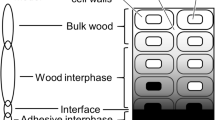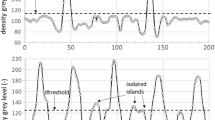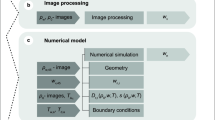Abstract
The permeation of fluid through wood is a crucial aspect of the drying and modification of this material. The accurate measurement of wood permeability and the analysis of the effects of microstructure on permeability are very challenging. The present study generated visual representations of the three-dimensional pore structures of wood specimens using X-ray computed tomography combined with image processing. In addition, axial seepage in wood samples was simulated based on seepage theory and structural information and microscopic gas flows were calculated to evaluate the macroscopic permeability of the wood. Finally, the simulation results were verified by comparison with experimental data and a detailed investigation of the effects of microstructure on permeability was performed. The porosity, average aperture, local connectivity ratio and fractal dimension of larch wood were evaluated based on the mesoscale resolution capacity of the tomography system and determined to be 0.638, 28.37, 0.67 and 1.779 µm, respectively. The average simulated axial gas permeability value of 5.256 µm2 was in the range of previously reported values (2.595–6.398 µm2). The permeability of the earlywood (6.555 µm2) was found to be significantly higher than that of the latewood (3.959 µm2). The accuracy of such simulations was determined to be affected by the wood properties, simulation method and testing equipment. Porosity, average aperture, and local connectivity ratio were the primary factors affecting permeability and these parameters were all positively correlated with permeability (with R2 values of 0.879, 0.814 and 0.721 respectively). The relationship between fractal dimension and permeability was unclear and requires further study.










Similar content being viewed by others
Availability of data and materials
Not applicable.
Code availability
Not applicable.
References
Adler PM (1994) Porous media: geometry and transport. Butterworth-Heineman, Stoneham
Ahmed SA, Chun SK (2011) Permeability of Tectona grandis L. as affected by wood structure. Wood Sci Technol 45:487–500
Ai W, Duval H, Pierre F, Perré P (2016) A novel device to measure gaseous permeability over a wide range of pressures: characterization of slip flow for Norway spruce, European beech and wood-based materials. Holzforschung 71:147–162
Ai W, Duval H, Pierre F, Perré P (2017) Characterization of wood micromorphology from gas permeability measurements. Microfluid Nano-Fluidics 21:101
Cai LP, Oliveira LC (2007) Gas permeability of wetwood and normal wood of subalpine fir in relation to drying. Dry Technol 25:501–505
Cheng JQ (1985) Wood science. China Forestry Publishing House, Beijing
Dullien FAL (1992) Porous media: fluid transport and pore structure. Academic Press Inc., New York
Elkhoury JE, Shankar R, Ramakrishnan TS (2019) Resolution and limitations of X-ray micro-CT with applications to sandstones and limestones. Transp Porous Med 129:413–425
Geng HQ, Jin H, Zhao JY (2021) Evaluation and quantification of wood 3D pore structure via XCT technology. For Eng 37(4):43–49
Hatzikiriakos SG, Avramidis S (1994) Fractal dimension of wood surfaces from sorption isotherms. Wood Sci Technol 28(4):275–284
Jang ES, Kang CW (2019) Changes in gas permeability and pore structure of wood under heat treating temperature conditions. J for Res 65:37
Kvist P, Gebäck T, Muzamal M (2019) Lattice Boltzmann simulations of diffusion in steam-exploded wood. Wood Sci Technol 53:855–871
Kvist P, Gebäck T, Rasmuson A (2020) A multi-scale model for diffusion of large molecules in steam-exploded wood. Wood Sci Technol 54:821–835
Li YF, Liu YX, Yu HP, Liu ZB (2011) Theory of fluids penetrating wood and its researching method. Sci Silvae Sin 47(2):134–144
Liu YX, Zhao GJ (2013) Wood resource materials science. China Forestry Publishing House, Beijing
Nguyen DM, Ameida G, Mai N, Zhang J, Perre P (2020) A critical review of current imaging techniques to investigate water transfers in wood and biosourced materials. Transp Porous Media 137:21–61
Palombini FL, Lautert EL, Mariath J, Oliveira B (2020) Combining numerical models and discretizing methods in the analysis of bamboo parenchyma using finite element analysis based on x-ray microtomography. Wood Sci Technol 54(1):161–186
Reynolds O (1883) An experimental investigation of the circumstances which determine whether the motion of water shall be direct or sinuous, and of the law of resistance in parallel channels. Philos Trans R Soc 174:935–982
Shi J, Avramidis S (2018) Dried cell wall nanopore configuration of Douglas-fir, red cedar and aspen heartwoods. Wood Sci Technol 52(4):1–13
Shi J, Avramidis S (2019) Evolution of cell wall nanopore size distribution in the hygroscopic range. Holzforschung 73(10):899–910
Tarmian A, Mastouri A (2018) Water-repellent efficiency of thermally modified wood as affected by its permeability. J for Res 29:859–867
Tekleyohannes A, Avramidis S (2010) Two-level self-organization of wood properties: a new paradigm for dimensional analysis and scaling. Wood Sci Technol 44(2):253–268
Wildenschild D, Sheppard AP (2013) X-ray imaging and analysis techniques for quantifying pore-scale structure and processes in subsurface porous medium systems. Adv Water Resour 51(1):217–246
Zhang P, Yong IL, Zhang J (2019) A review of high-resolution x-ray computed tomography applied to petroleum geology and a case study. Micron 124:102702
Zhao JY, Yang L, Cai YC (2021) Combining mercury intrusion porosimetry and fractal theory to determine the porous characteristics of wood. Wood Sci Technol 55:109–124
Zhu HQ, Bao FC (2002) The three-dimensional flow resistor network for radial and tangential gas permeability of softwoods. Sci Silvae Sin 38(6):93–98
Acknowledgements
The project was supported by the “National Natural Science Foundation of China” and “National Undergraduate Training Programs for Innovations”, Grant Nos.: 32271786, 31901242 and 202210225086. We thank Liwen Bianji (Edanz) (https://www.liwenbianji.cn) for editing the language of a draft of this manuscript.
Author information
Authors and Affiliations
Corresponding author
Additional information
Publisher's Note
Springer Nature remains neutral with regard to jurisdictional claims in published maps and institutional affiliations.
Rights and permissions
Springer Nature or its licensor (e.g. a society or other partner) holds exclusive rights to this article under a publishing agreement with the author(s) or other rightsholder(s); author self-archiving of the accepted manuscript version of this article is solely governed by the terms of such publishing agreement and applicable law.
About this article
Cite this article
Zhao, J., Li, L., Lv, P. et al. A comprehensive evaluation of axial gas permeability in wood using XCT imaging. Wood Sci Technol 57, 33–50 (2023). https://doi.org/10.1007/s00226-022-01449-z
Received:
Accepted:
Published:
Issue Date:
DOI: https://doi.org/10.1007/s00226-022-01449-z




